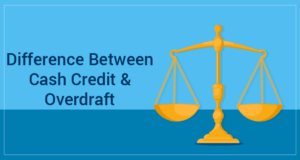![]()

Bank Overdraft & Cash Credit
Bank overdraft and cash credit facilities are both forms of short-term borrowing provided by financial institutions to individuals and businesses.
Here’s a detailed explanation of each:
1. Bank Overdraft:
i. An overdraft is a financial arrangement where a bank allows an account holder to withdraw funds from their account even if the available balance is zero or negative, up to an agreed-upon limit.
ii. It is a flexible form of borrowing, as the account holder can access funds as needed, up to the authorized limit, without needing to apply for a new loan each time.
iii. Overdrafts are typically use for short-term cash flow management, covering unexpected expenses, or bridging temporary gaps in funds.
iv. Interest is charge only on the amount overdrawn and for the period it is utilized.
v. Overdraft facilities may be secure or unsecure, depending on the borrower’s relationship with the bank and their creditworthiness.
2. Cash Credit Facility:
i. Cash credit is a type of revolving credit facility provid by banks to businesses based on their working capital requirements.
ii. Under this arrangement, the bank allows the borrower to withdraw funds up to a specified limit against a pledge of assets or personal guarantee.
iv. Similar to an overdraft, cash credit provides flexibility in borrowing, as the borrower can withdraw funds as needed, up to the approved limit, without requiring a new loan application each time.
v. Interest is chargde on the amount utilized, similar to an overdraft, and for the duration of its use.
vi. Cash credit facilities are commonly utilized by businesses to finance their day-to-day operations, manage inventory, or meet short-term financing needs.
Key differences between Bank Overdraft & Cash Credit Facility:
1. Nature of Borrowing:
i. Overdraft: Generally used by both individuals and businesses for short-term financing needs, covering unexpected expenses or temporary cash flow gaps.
ii. Cash Credit: Primarily utilized by businesses to meet their working capital requirements, such as purchasing inventory, managing operational expenses, or funding production cycles.
2. Security:
i. Overdraft: May be secure or unsecured, depending on the account holder’s relationship with the bank and their creditworthiness.
ii. Cash Credit: Typically secured by assets or personal guarantees provided by the borrowing business.
3. Usage:
i. Overdraft: Provides flexibility for both individuals and businesses to access funds as needed, up to the authorized limit, usually through their bank account.
ii. Cash Credit: Mainly used by businesses to finance day-to-day operations, manage cash flow, and meet short-term working capital needs.
Both bank overdraft & cash credit facilities offer flexibility and convenience in accessing funds, but they cater to different financial needs and are structured accordingly to meet the requirements of individuals and businesses.
Visit for more information: https://www.rbi.org.in/
FAQs on Bank Overdraft & Cash Credit:
1. What is Bank Overdraft?
Ans: An overdraft is a financial arrangement provide by a bank that allows an account holder to withdraw more money than is currently available in their account, up to an agreed-upon limit.
It’s a form of short-term borrowing where the bank covers the shortfall, and the account holder incurs interest charges on the overdrawn amount.
Overdrafts are commonly use to manage temporary cash flow shortages or cover unexpected expenses.
2. What is Cash Credit?
Ans: Cash Credit is a type of short-term revolving credit facility offered by banks to businesses.
Under this arrangement, a borrower can withdraw funds up to a predetermined limit as need, typically to meet working capital requirements such as purchasing inventory, managing operational expenses, or funding production cycles.
Interest is charge only on the amount utilized, and the borrower can repay and reuse the credit line as per their cash flow needs.
This facility is usually secure by assets or personal guarantees provided by the borrowing business.
3. What is the difference between cash credit and overdraft?
Ans: Cash Credit: Typically used by businesses for working capital needs, with funds accessed against assets or personal guarantees, often for specific purposes like inventory management or operational expenses.
Overdraft: Offers flexibility for individuals and businesses to withdraw funds from their account beyond the available balance, usually for short-term needs or unexpected expenses, with interest charged only on the overdrawn amount.
4. Is there any charge for opening bank overdraft & Cash Credit?
Ans: Yes, there are typically charges associate with opening both overdraft and cash credit facilities.
Here’s a brief overview:
1. Overdraft:
1. Banks may charge an arrangement fee or processing fee for setting up an overdraft facility. This fee covers administrative costs incurred by the bank in processing the application and establishing the overdraft limit.
2. Additionally, there may be annual maintenance fees or service charges associated with keeping the overdraft facility active, even if it is not utilized.
3. Interest is charge on the amount overdrawn, but there may also be a minimum usage fee if the overdraft facility remains unused.
Cash Credit:
1. Similar to overdrafts, banks may levy an arrangement fee or processing fee for establishing a cash credit facility. This fee covers the administrative costs of setting up the arrangement and determining the credit limit.
2. There may be annual maintenance charges or service fees for maintaining the cash credit facility, irrespective of its utilization.
3. Interest is charge on the amount utilized under the cash credit facility, but there may also be a minimum usage fee if the facility remains unused.
4. These charges vary depending on the bank’s policies, the borrower’s credit profile, and the specific terms negotiate between the bank and the borrower.
For further details access our website: https://vibrantfinserv.com